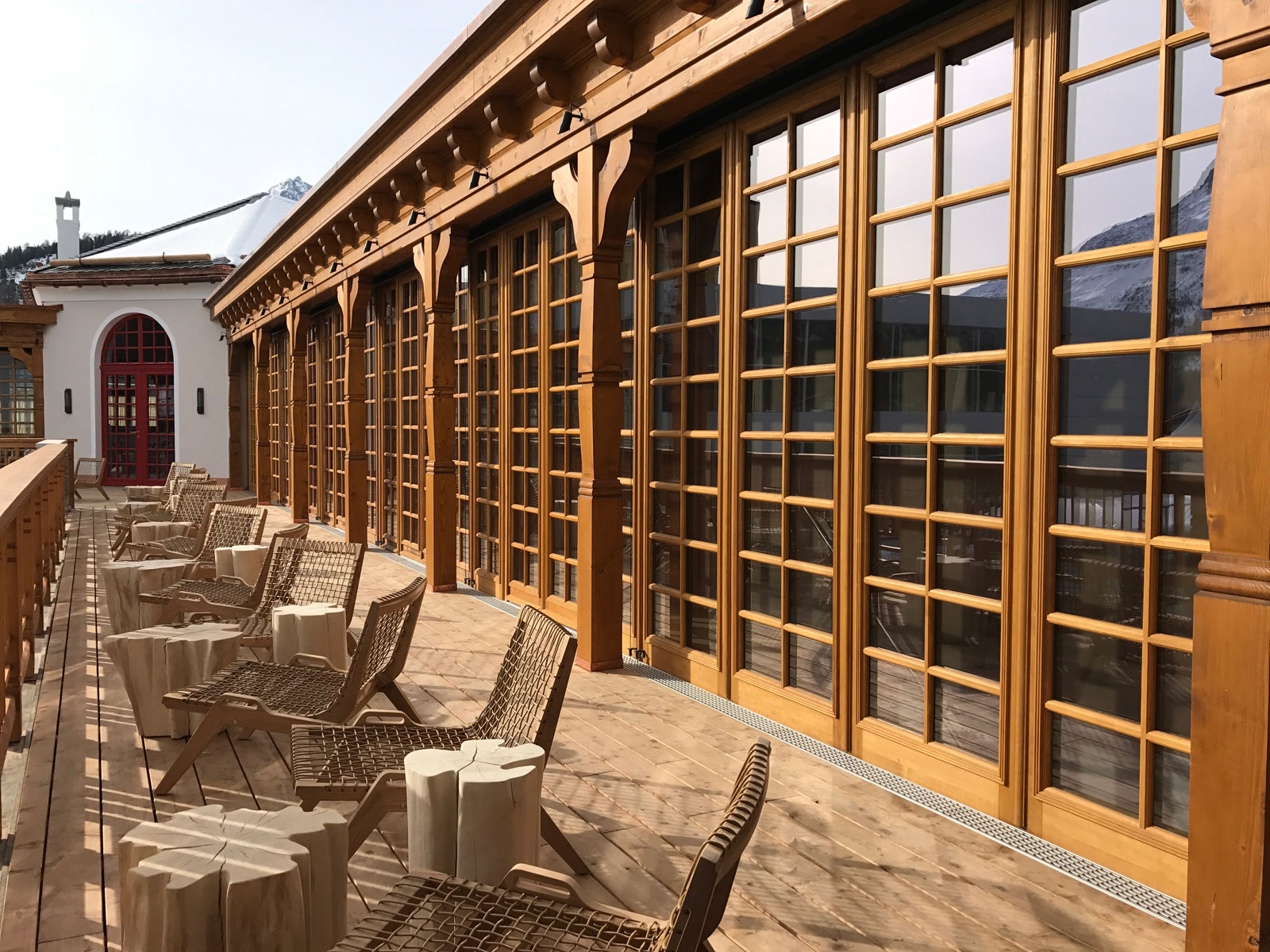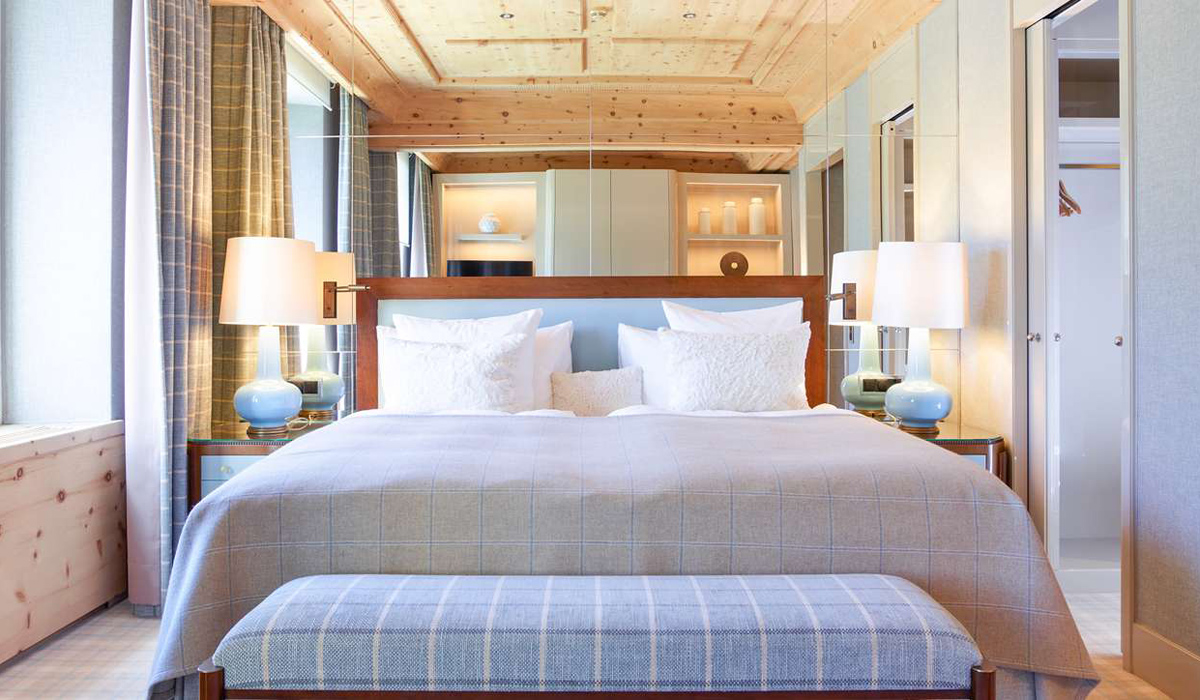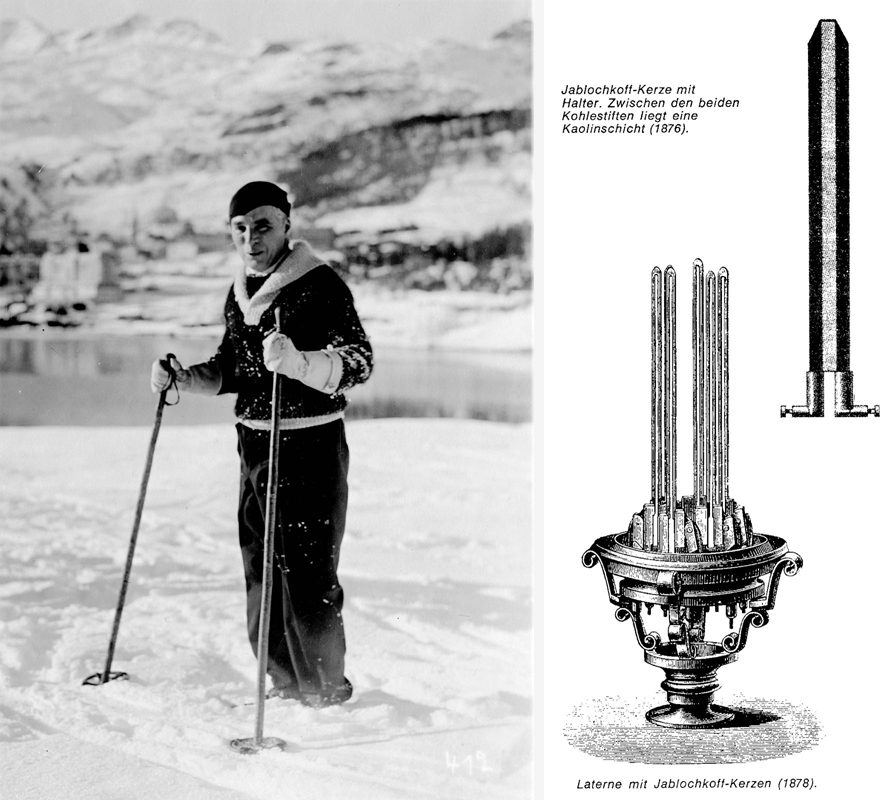Five Facets of The Historic Kulm Hotel St Moritz
Lord Norman Foster’s recent pavilion overhaul, Switzerland’s first lightbulb, a pillow menu and more

Tucked in the southeastern corner of Switzerland, the Engadine valley—and its centerpiece St Moritz—carries a century and a half of history and stakes claim to the birth of Swiss winter tourism. A region of four languages—Italian, Swiss-German, French and the historic Romansh—the valley dominated jet-setting headlines in the ’50s and ’60s. Today, it’s still a haven of luxury, world-class outdoor sports and après ski, but there’s a sense that it’s all grown up (and even family friendly). At the heart of St Moritz stands the iconic Kulm Hotel, where it all began. Hotelier and founder Johannes Badrutt dared summertime guests to return for winter in 1864 and they did, bringing a sense of adventure and, the following season, all of their friends. Today, the Kulm is one of a handful of five-star establishments in town. Not only does it provide serene vistas and antique decor that pulls the past forward, but notable elements such as their “pillow menu” and a pavilion renovation by Lord Norman Foster hammer home its contemporary relevance. For the modern traveler who’s truly in search of destinations with a story, we’ve chosen to share five here stretching from the Kulm’s beginnings to its most recent grand unveil.

Lord Norman Foster revitalizes the Kulm Country Club
The last weekend of January 2017, star architect Lord Norman Foster welcomed the return of guests to Kulm Country Club: a pavilion with a restaurant and bar on the hotel’s stretch of central property. Far from new, the Kulm Country Club debuted back in 1905. It was the official event base for the Winter Olympics in both 1928 and ’48. During the ’80s, however, it fell into disrepair. Lord Foster, along with Küchel Architects AG, used 110 cubed meters of wood and 3000kg of steel to revive the facility over 10 months. Within, Lord Foster and his wife (among others) hand-selected ephemera from the hotel’s archives (like the 1920s image below) to support the historic wooden window frames, beams and girders. “We utilized stuff that was just lying buried,” he explains to CH. “Some of the drawings and painting and photographs had been in storage—now they service the history.” There’s a reverence to the pavilion, but it’s not a museum. Rather, it’s destined to be a local hot spot.

“We are trying to make it so that the things that make it work, you are not really aware of,” he continues. “When you look at the tribunes under the cantilever roof, you don’t think ‘kitchen,’ but that’s the kitchen that makes it all possible. It was also doing a lot of tidying up. We have incorporated all the functionality necessary for its future.” Eleven Madison Park’s Daniel Humm (Swiss himself) kicks off a pop-up residency within—to then be replaced by Michelin-starred chefs Nenad Mlinarevic and then Mauro Colagrecco. An iceskating rink and curling pond will return shortly—after the 2017 Alpine Ski World Cup.

Some 12 million CHF went into the restoration and expansion, which adhered to the region’s strict preservation codes. “I felt a sense of duty, quite aside from any of the architectural challenges,” Foster says. “There’s an extraordinary amount of the original fabric that we have been able to conserve… It’s a highly symbolic building.” Beyond incorporating the history, he adds, “We saw it as an urban opportunity to go beyond the building and to celebrate the space, the ice rink, the sporting activities, to make it much more a social hub.” From the revival of the red coloration of the font to the modern storage areas for ice rink equipment, there is a synergy of past and present.

Pierre-Yves Rochon’s 26 Rooms
The story of the Kulm Country Club may be the most pressing, but there’s another recent investment worth expounding upon. For the winter 2015 season, the Kulm’s ownership overhauled one wing—carefully, however, as many of the rooms receive return visitors year after year. Known as the Neukulm wing, 33 rooms were reduced and rearranged to 26 (the entire hotel maxes out at 172 rooms and suites). Designed by Pierre-Yves Rochon, each room features regional Swiss stone pinewood—which lends a multi-sensory impact, including an alluring fragrance. There are two colorways, either beige or sky blue, and both deliver contemporary elegance. On our stay, we occupied an older guest room with a balcony. It was spacious and nuanced, but the Rochon rooms truly embody the grand hotel stylings of today. Seven million CHF went into a development aimed at quiet and comfort.

The Pillow Menu
Amenities are in no shortly supply at the Kulm, with a 2,000 square-meter spa, five restaurants and three bars—not to mention access to the outside activities. Here, however, we were most taken by the pillow menu. For anyone unfamiliar with a pillow menu, it’s exactly as it sounds. Prior to bed, guests can peruse the eight-item menu with options such as the micro-modal satin Ottimo fiber pillow (easy to plump up) and the Swiss mountain herbs millet pillow (which exudes a light fragrance) and have them delivered. Sizes vary. Firmness/density options are aplenty. Some are warmed, others come with lavish scent profiles and infusions as mentioned. Our personal favorite, the Cherry Pit Warmer, exudes warmth. Known as the Chriesisteisäckli, this pillow arrives heated and soothes—especially satisfying after a day on the slopes.

Charlie Chaplin + Switzerland’s First Lightbulb
What’s an iconic hotel without two telling anecdotes from a storied history? Long before the swagger of the swinging decades, the Kulm played host to one of the most famous names in film: Charlie Chaplin. A notorious hater of cold weather, Chaplin and his brother Syd found themselves in St Moritz and staying at the Kulm. It was here that Chaplin famously learned how to ski in 1928—and also fell in love with the region. If a tale of classic Hollywood doesn’t appeal, the Kulm also has quite an innovate stake in history: it housed Switzerland’s first-ever lightbulb. Hotel founder Badrutt had seen the debut of arc-lights at the Paris World Fair and, soon after, built an electricity facility and illuminated the Grand Restaurant back in 1878. When visitors walk through the hotel today, these stories infuse the lush environs with charm.

To return to Lord Norman Foster, a part-time resident of the Engadine, “It’s a magic area,” he says to us. “There is nowhere else like it; all of the different villages with their own identity, each with their own extraordinary, historic architecture. It’s also the nature, the cross country skiing—the way it all comes together,” he concludes. Flights directly to the Engadine can be expensive, but flying is by no way the only means to get there. The train from Zurich, around three hours long, offers a panoramic car and as a voice announces the importance of bridges and tunnels while winding up the mountains, it’s an extraordinary way to travel.
Book a room at the Kulm Hotel St Moritz online, with prices starting at 240 CHF per night.
Present day Kulm County Club images by David Graver, all other images courtesy of the Kulm Hotel












